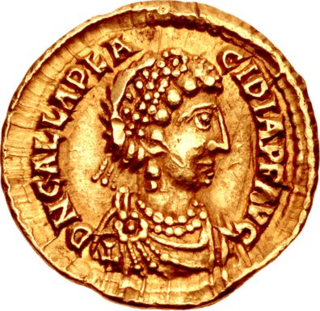
Honorius was Roman emperor from 393 to 423. He was the younger son of emperor Theodosius I and his first wife Aelia Flaccilla. After the death of Theodosius in 395, Honorius, under the regency of Stilicho, ruled the western half of the empire while his brother Arcadius ruled the eastern half. His reign over the Western Roman Empire was notably precarious and chaotic. In 410, Rome was sacked for the first time since the Battle of the Allia almost 800 years prior.

Galla Placidia, daughter of the Roman emperor Theodosius I, was a mother, tutor, and advisor to emperor Valentinian III. She was queen consort to Ataulf, King of the Visigoths from 414 until his death in 415, briefly empress consort to Constantius III in 421, and managed the government administration as a regent during the early reign of Valentinian III until her death.
The 400s decade ran from January 1, 400, to December 31, 409.
The 380s decade ran from January 1, 380, to December 31, 389.
The 430s decade ran from January 1, 430, to December 31, 439.
The 500s decade ran from January 1, 500, to December 31, 509.
The 510s decade ran from January 1, 510, to December 31, 519.
The 540s decade ran from January 1, 540, to December 31, 549.
The 420s decade ran from January 1, 420, to December 31, 429.

Year 414 (CDXIV) was a common year starting on Thursday of the Julian calendar. At the time, it was known as the Year of the Consulship of Constantius and Constans. The denomination 414 for this year has been used since the early medieval period, when the Anno Domini calendar era became the prevalent method in Europe for naming years

Year 450 was a common year starting on Sunday of the Julian calendar, the 450th Year of the Common Era (CE) and Anno Domini (AD designations, the 450th year of the 1st millennium, the 50th year of the half of 5th century, and the 1st year of the 450s decade. At the time, it was known as the Year of the Consulship of Valentinianus and Avienus. The denomination 450 for this year has been used since the early medieval period, when the Anno Domini calendar era became the prevalent method in Europe for naming years.

Year 400 (CD) was a leap year starting on Sunday of the Julian calendar. In the Roman Empire, it was known as the Year of the Consulship of Stilicho and Aurelianus. The denomination 400 for this year has been used since the early medieval period, when the Anno Domini calendar era became the prevalent method in Europe for naming years.

Year 399 (CCCXCIX) was a common year starting on Saturday of the Julian calendar. At the time, it was known in Rome as the Year of the Consulship of Eutropius and Theodorus. The denomination 399 for this year has been used since the early medieval period, when the Anno Domini calendar era became the prevalent method in Europe for naming years.
The 390s decade ran from January 1, 390 to December 31, 399
The 410s decade ran from January 1, 410, to December 31, 419.
The 440s decade ran from January 1, 440, to December 31, 449.
The 460s decade ran from January 1, 460, to December 31, 469.

Year 535 (DXXXV) was a common year starting on Monday of the Julian calendar. At the time, it was known as the Year of the Consulship of Belisarius without colleague. The denomination 535 for this year has been used since the early medieval period, when the Anno Domini calendar era became the prevalent method in Europe for naming years.
Year 380 (CCCLXXX) was a leap year starting on Wednesday of the Julian calendar. At the time, it was known as the Year of the Consulship of Augustus and Augustus. The denomination 380 for this year has been used since the early medieval period, when the Anno Domini calendar era became the prevalent method in Europe for naming years.

Year 460 (CDLX) was a leap year starting on Friday of the Julian calendar. At the time, it was known as the Year of the Consulship of Magnus and Apollonius. The denomination 460 for this year has been used since the early medieval period, when the Anno Domini calendar era became the prevalent method in Europe for naming years.








